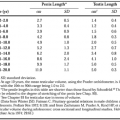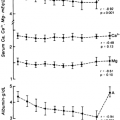THYROTROPIN RECEPTOR ANTIBODIES
Part of “CHAPTER 33 – THYROID FUNCTION TESTS“
Certain thyroid disorders have been associated with an immunologic abnormality. Early bioassays, such as the long-acting thyroid stimulator and its protector assay, demonstrated that the immunoglobulin of patients with Graves disease stimulates thyroid hormone secretion. Several functional types of antibodies are now recognized to exist (see Chap. 42). Although these antibodies appear to interact with thyroid follicular cell receptors, their effects are varied. Some antibodies promote thyroid gland function (thyroid-stimulating antibodies), some inhibit the binding of TSH to its receptor (thyroid-binding inhibitory immunoglobulins), and some enhance or inhibit thyroid growth. These antibodies are measured by a variety of bioassays and receptor assays.33,34 and 35 Patients may present with hyperthyroidism, hypothyroidism, goiter, or thyroid atrophy. Pregnant women with high titers of these antibodies may give birth to infants with transient hyperthyroidism or hypothyroidism.36
PERIPHERAL INDICES OF THYROID FUNCTION
Serum thyroid hormone measurements are essential for making the diagnosis of thyroid dysfunction. Usually, altered levels of T4 and T3 correlate well with the patient’s clinical presentation, and the diagnosis of hyperthyroidism or hypothyroidism is readily made. In some situations, however, the patient’s metabolic status is not apparent from the thyroid blood tests. Such occurrences are expected in euthyroid hyperthyroxinemia37 and nonthyroidal illnesses3 (see Chap. 36). For instance, patients with thyroid hormone resistance have high serum T4 and T3 levels yet may appear euthyroid. The recommendation is that
many target organs be evaluated clinically because tissue responses may be in the hyperthyroid, euthyroid, or hypothyroid range owing to heterogeneity of tissue resistance.38,39 Patients with nonthyroidal illness have low serum T3 levels and sometimes low T4 levels as well. No consensus yet exists about whether these patients are completely euthyroid or whether their tissues are hypothyroid, perhaps as a protective response to conserve precious energy stores.
many target organs be evaluated clinically because tissue responses may be in the hyperthyroid, euthyroid, or hypothyroid range owing to heterogeneity of tissue resistance.38,39 Patients with nonthyroidal illness have low serum T3 levels and sometimes low T4 levels as well. No consensus yet exists about whether these patients are completely euthyroid or whether their tissues are hypothyroid, perhaps as a protective response to conserve precious energy stores.
Stay updated, free articles. Join our Telegram channel

Full access? Get Clinical Tree






